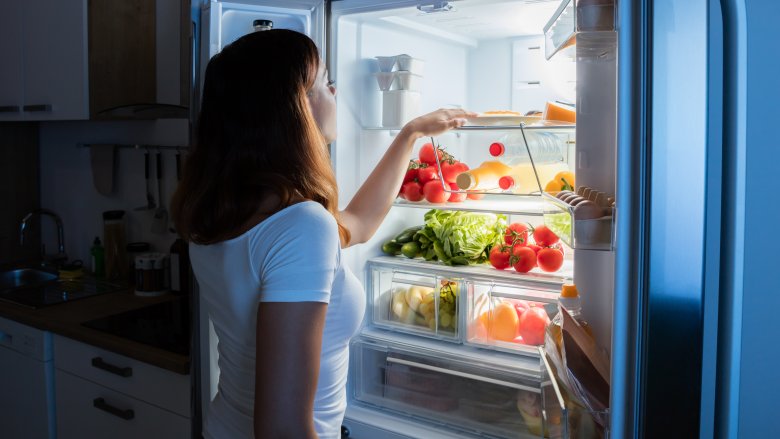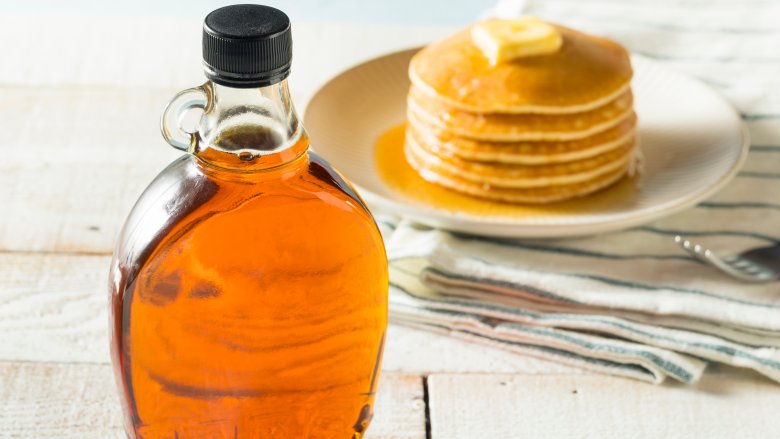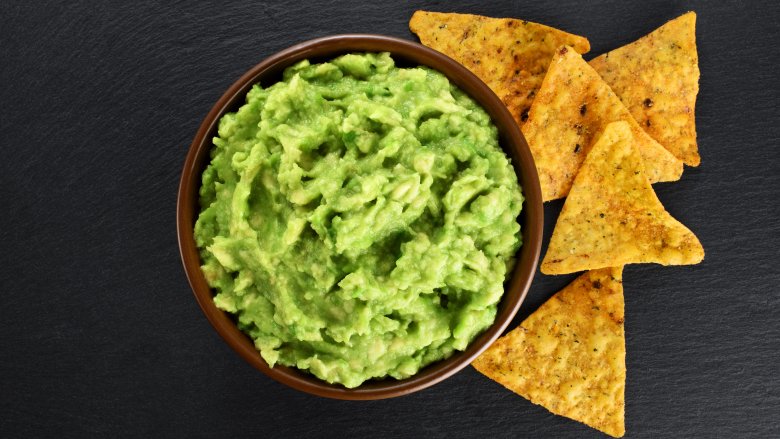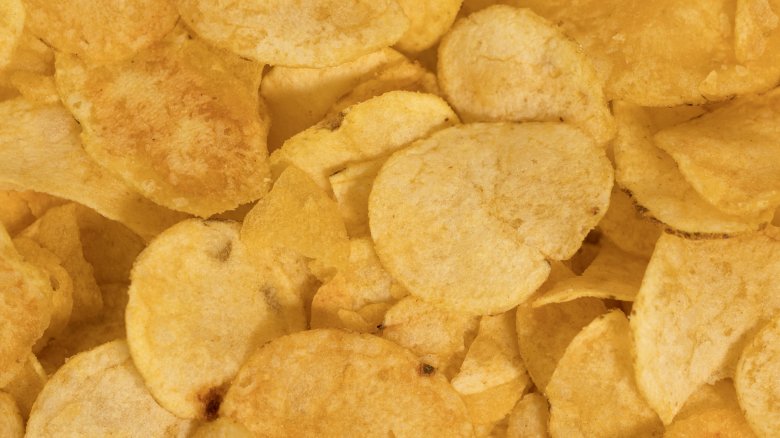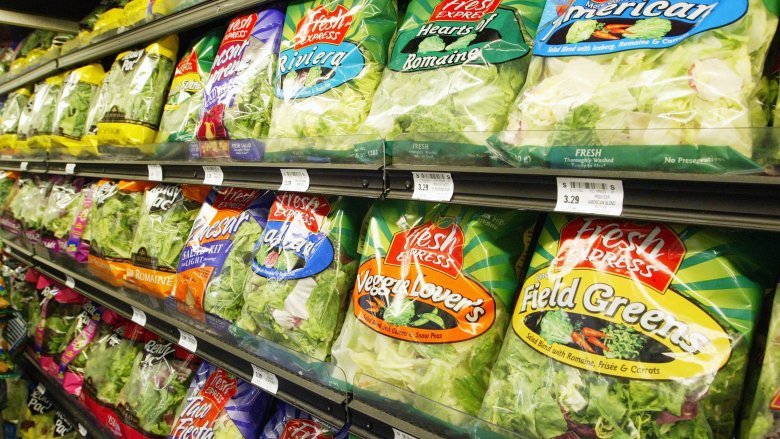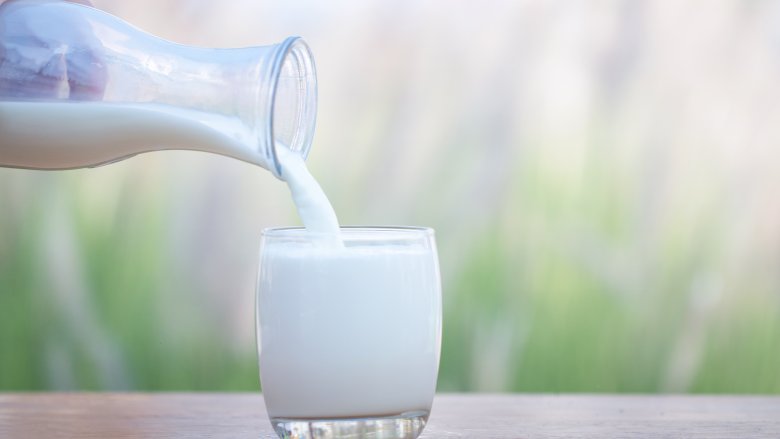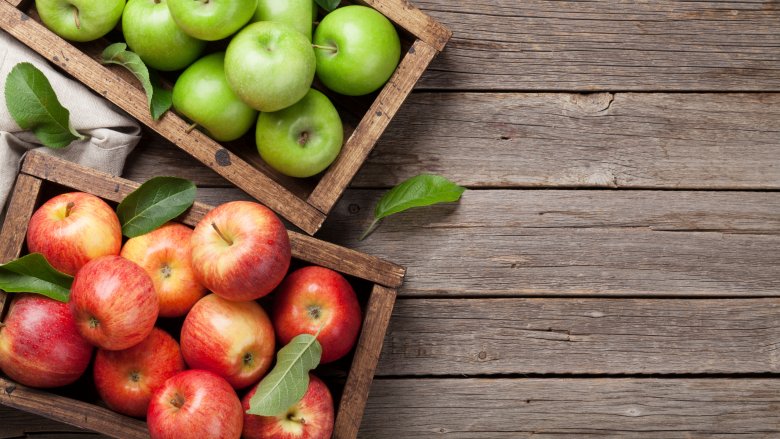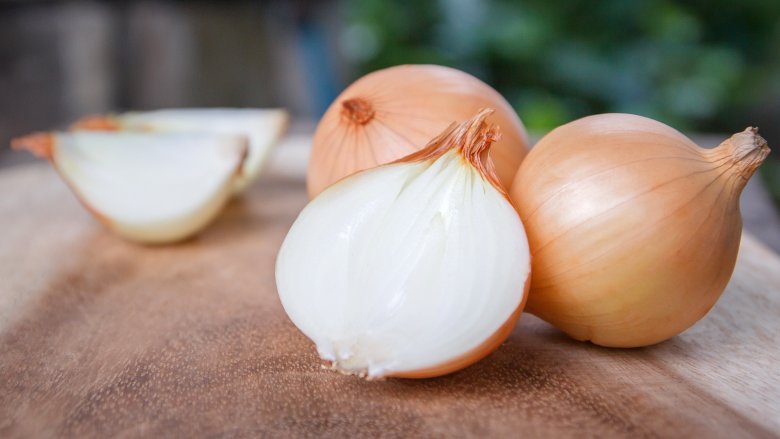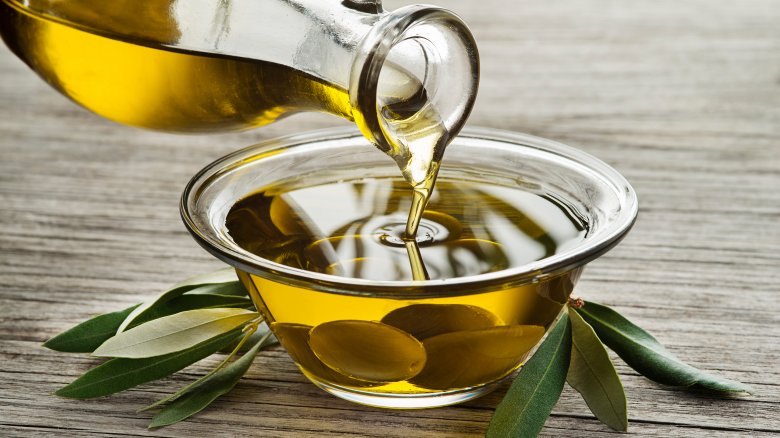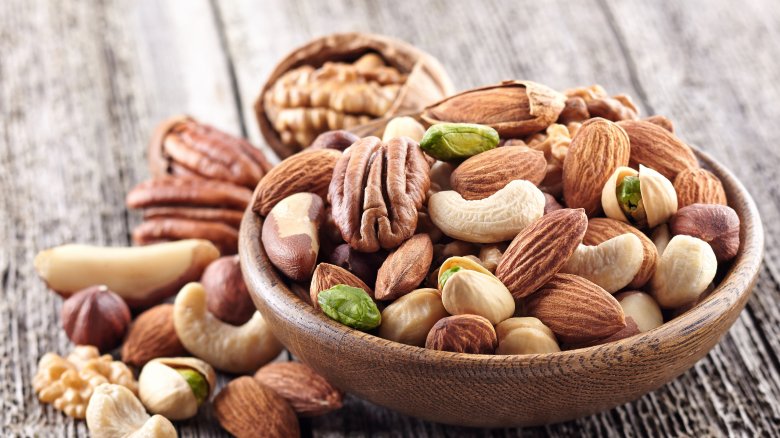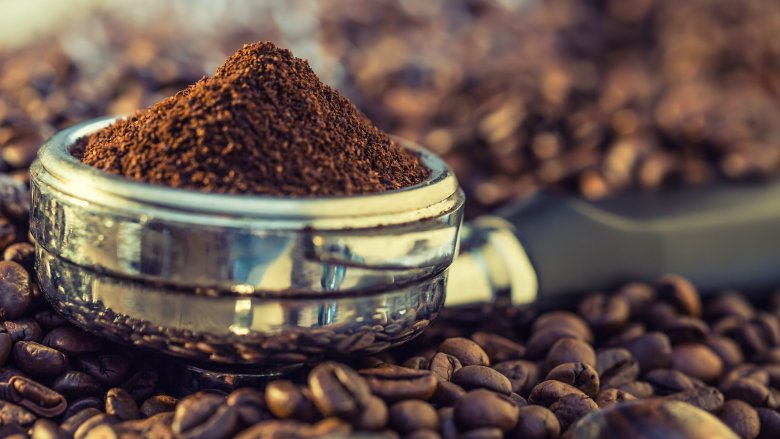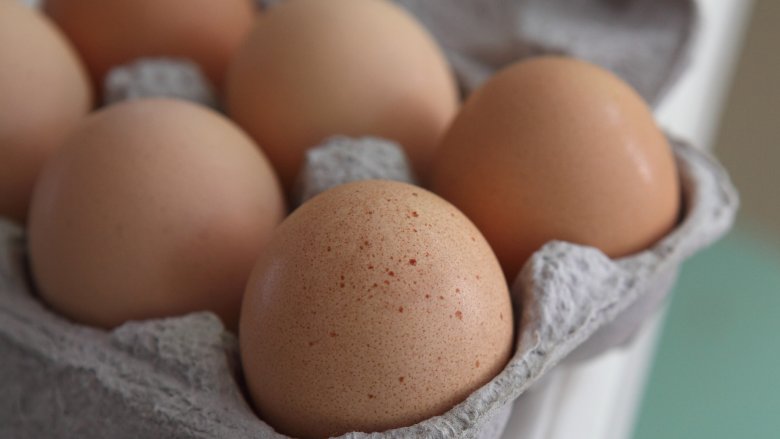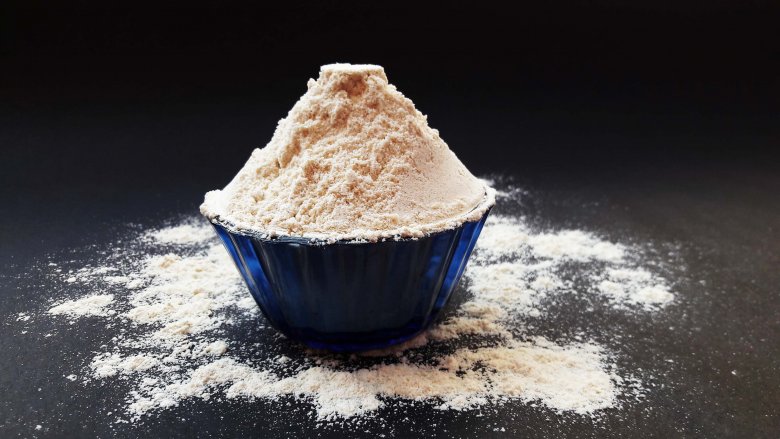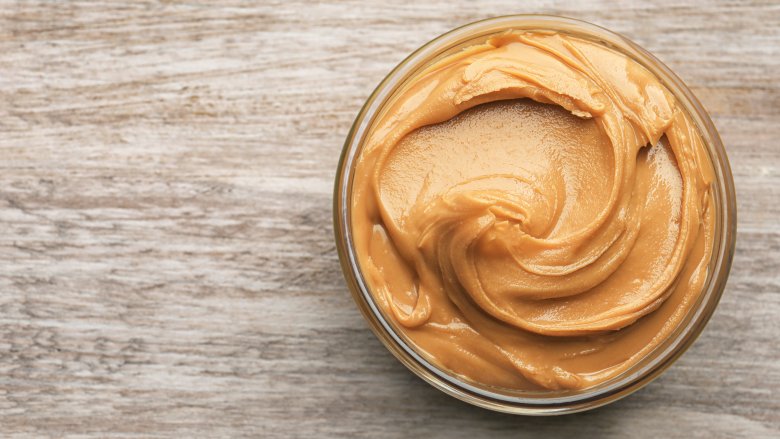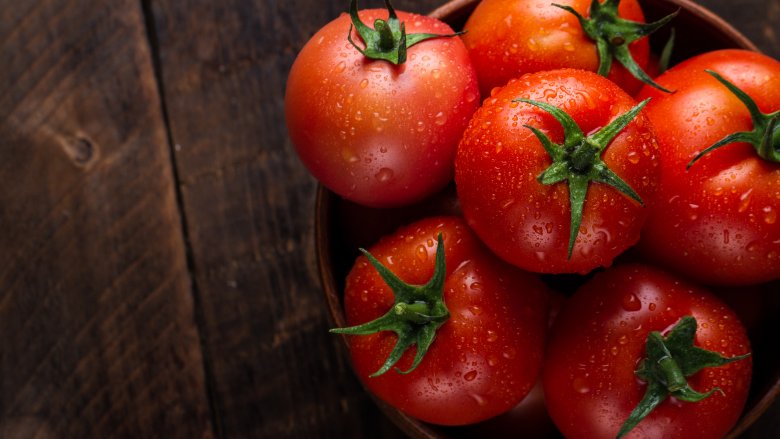You've Been Storing These Foods Wrong The Entire Time
Re-organizing your kitchen is a tedious chore — and something you probably don't think you even need to do. After all, you've been adulting long enough to know that the chips go in the pantry, the milk goes in the refrigerator door, and the tomatoes go in that fancy drawer at the bottom of your fridge. Or do they?
In fact, there's a good chance that you've been storing a lot of foods completely wrong your entire life without even knowing it. So what's the harm if you've been doing it that way for years? Changing up the way you store these foods will not only help them taste better, but it will also make them last longer, and that's a big deal that effects more than just your budget — though the reduced grocery bill certainly won't hurt either.
According to the USDA, 30 to 40 percent of the food supply in the United States ends up as waste. On top of that staggering statistic, they also say food waste makes landfills the third-largest source of methane in the United States. You can eliminate some of that food waste just by being aware of some of the bad food storage practices you're exhibiting in your kitchen right now.
These are the foods you've been storing wrong.
Maple syrup lasts longer when it's kept cold
When you're eating pancakes drenched in syrup, pure maple syrup is the way to go.
Let's be clear, maple syrup isn't exactly healthy. According to Healthline, a ⅓ cup serving of maple syrup contains nearly 60 grams of sugar. But sugar content aside, pure maple syrup is a better alternative to the artificial varieties on the market. Unless the bottle is labeled "pure maple syrup," you're likely drenching your pancakes in a sticky blend of high fructose corn syrup, artificial flavors, and preservatives. And if you bought the real stuff, you don't want to keep it on a shelf in your pantry.
According to the Massachusetts Maple Producers Association, pure maple syrup can be stored safely in your pantry as long as the bottle has not been opened. But because it is free of preservatives, once you open a bottle of pure maple syrup, it needs to be stored in the refrigerator. Otherwise, mold will begin to grow on the surface — and moldy syrup won't do those pancakes any favors.
Your guacamole should be stored with a little water
Guacamole is one of those appetizers that usually tastes good the next day, but definitely doesn't look the part. If you're hosting a party, guacamole is usually one of the last things you prepare before your guests arrive. Because once the air hits your guac, your beautiful green concoction turns into a gross brown mess. The color change is the result of a reaction between an enzyme in your avocado and the oxygen found in the air, according to Eat or Toss.
But there is a way to preserve your guacamole and make sure you have at least a couple of days to dip your chips into your delicious creation. Kitchn suggests adding a half-inch layer of water to the top of your guacamole before you put it in the fridge, to protect it from the air that zaps all of the color away. Doing this should preserve your guacamole for up to three days.
When you're ready to eat, all you have to do is pour the water off of the top, stir your guacamole, and serve.
You should store your chips in the freezer
There's nothing worse than searching your pantry for something to satisfy your intense salty snack craving only to find a bag of stale potato chips waiting for you instead. But that doesn't mean you have to eat all of the chips right away. It just means that you need to change the way you're storing them. According to Life Hacker, moving your chips from the cabinet to the freezer can help extend their life for a few more months.
Potato chips contain very little water, which means that spending a little time in the freezer will make them cold, but won't cause them to freeze. In fact, you'll find that you can practically start snacking as soon as you take them out. Just make sure you keep your bag of chips in a safe place inside of your freezer away from your heavier foods, or you may find a bag of cold crumbs waiting for you when you're ready to eat.
Keep your bagged salad fresh by keeping it dry
Whether you eat them as-is or use them as a base for a more creative salad concoction, bagged salads can be a quick and convenient way to enjoy a fresh salad without having to go through all of the hassle of chopping lots of veggies. But if you've ever actually bought a bagged salad, you know that once you get them home, you only have a short window of time to use all of the contents. Otherwise, you'll find a big, soggy mess where your beautiful fresh greens used to be.
But there is a way to keep your salad from going bad too quickly and extend the life of your lettuce. When you bring your bagged salad home from the store, place a paper towel inside of the bag with your greens before you place them in the refrigerator, as Delish advises. The paper towel will help absorb some of the extra moisture that causes the lettuce to wilt.
Milk has no place on the refrigerator door
The refrigerator door may seem like an ideal place to store your milk. In fact, your carton may fit perfectly between your ketchup and your emergency bottle of Chardonnay. But the truth is, the door shelves are probably the last place in your fridge that you'd want to keep any of your dairy products.
Every time you or someone else in your house opens the fridge to grab a drink or a snack, you're exposing the food sitting on the door to the warm temperatures inside of your kitchen. This means that the door shelves are actually the warmest part of your refrigerator, according to Real Simple. And the constant temperature fluctuation puts all of your dairy products at risk for the growth of harmful bacteria and spoilage.
It's much safer to store your milk and other dairy products near the back of the refrigerator on one of the lower shelves. This part of the fridge stays much cooler and will ensure that your milk is safe to drink.
Apples need to be cool to stay crisp
Fresh apples can look almost too good to eat when they're beautifully displayed in a bowl on your counter or dining room table. But unfortunately, the fruit bowl is not the best place to store your apples if you want to keep them fresh.
According to Food Network, your apples will keep their crispy texture longer if you keep them cool in the refrigerator, rather than at room temperature. The ideal temperature for apple storage is between 30 and 35 degrees Fahrenheit, as Garderners.com adds.
So when you bring your Golden Delicious and your Granny Smiths home from the supermarket, place them in a plastic bag with holes and place them in the crisper drawer of your fridge. This will give you even more time to enjoy their fresh taste. Just be sure to keep your apples away from your lettuce and other veggies. Apples emit the ripening gas, ethylene, which may cause your vegetables to go bad prematurely.
The pantry is the place for onions
If you keep your onions in the refrigerator crisper with the rest of your vegetables, you're not alone. But while it might be convenient to have all of your salad fixings in one place, you should know that the conditions inside of your refrigerator are not ideal for your onion's long term survival.
As HuffPost noted, the refrigerator's cold temps will turn your onion's starch into sugar, a process which will cause the onion to soften and leave a lingering onion odor inside of your fridge. If you leave your onions out at room temperature, they will last around one week before going bad. Instead, Eating Well recommends storing your onions in a pantry that is cool, dry, and dark, where they will last up to a month.
But when you're looking for a place in your pantry to keep your onions, it's important to remember that they should not be stored near your potatoes, according to HuffPost. When kept close together, the potatoes give off moisture and gasses which will cause the onion to ripen and spoil faster.
Protect your olive oil from heat and light
If you cook with olive oil regularly, it may seem convenient to keep it as close to the stove as possible for easy access. But while you may save yourself a few steps to the pantry, it may ultimately end up costing you at the grocery store. The heat from your stove will cause your olive oil to lose some of its flavor and eventually go bad, as Kitchn noted. And having to replace your olive oil before finishing the bottle can seriously blow your grocery budget.
According to Epicurious, olive oil should last for a month or two when it is stored properly. If you want to keep your olive oil fresh, it should be kept in a jar, and stored in a cabinet away from heat and light. The ideal temperature for storing olive is 57 degrees, according to Kitchn. But you should make sure the temperature doesn't get too cold. According to Delish, your olive oil will get hard if you store it in the fridge.
Store nuts in the freezer for guaranteed snack satisfaction
Mixed nuts are a healthy natural snack. Loaded with protein, vitamins and the good kind of fat, a handful of almonds or cashews is a lot better for your diet than a handful of potato chips, as Health Magazine pointed out. But the same fats that can keep your cholesterol low and your heart healthy can cause nuts to spoil if they aren't stored properly.
You can safely store your almonds, pecans, and walnuts in your pantry for up to two weeks. But if you haven't eaten them all up by then, you'll need to move them to a cooler location. As the Food Network suggests, nuts are safe in the refrigerator for up to 9 months. They'll keep in the freezer for 2 years.
But wherever you decide to store nuts, you should make sure that the container is tightly sealed. As Food 52 mentioned, leaving the container open can cause the nuts to pick up odors of other foods you have stored nearby. And no one wants to snack on garlic-flavored almonds.
Preserve the flavor of your coffee by keeping it at room temperature
Bad beans can be a coffee lovers worst nightmare. The quality of the beans has a direct impact on the integrity of the flavor — and on whether or not you enjoy your morning cup of coffee. You may think that refrigerating your coffee is helping to preserve its flavor. But storing your beans in the fridge actually diminishes the flavor instead, according to Prevention.
According to the National Coffee Association of USA, air, moisture, heat, and light are the worst possible conditions for your coffee beans. The best way to ensure you enjoy your morning cup, is to make sure that your beans are protected from the elements that can compromise their flavor. In order to make sure your coffee beans remain fresh, they should be stored in an airtight container in a dark, cool location somewhere around room temperature, as the NCAUSA recommended.
Just be sure to avoid storing your coffee in a clear container, to protect your beans from overexposure to light.
Eggs shouldn't be stored in decorative trays
Storing eggs properly is important for maintaining their safety. As the FDA says, storing your eggs properly helps to keep them safe from harmful bacteria that can contaminate them and cause you to get sick.
Resist the urge to move your eggs into that cute little egg container you picked up at TJ Maxx when you get them home. Keeping the eggs in their original carton protects them from breaking and taking on the odors of the food stored nearby, as Kitchn recommended.
And like milk, eggs shouldn't be stored in the refrigerator door. Eggs are best when they're stored on the middle shelf, which is the coldest part of the refrigerator, according to The Spruce Eats. There, they should stay fresh for up to 5 weeks.
If you think you won't be able to use all of your eggs before they go bad, you can freeze them, according to the American Egg Board. Remove the eggs from their shells and seal them tightly in a freezer-safe container, where they will last up to one year.
Whole wheat flour needs to be sealed tightly
Eating whole grains can lower your risk of diabetes, heart disease, heart disease, and high blood pressure, according to Healthline. Whole wheat flour is a great tool for healthy cooking, but when it isn't stored properly, it can begin to taste bitter. Ultimately, that bad taste can ruin whatever you are cooking, according to flour manufacturer, King Arthur. They suggest storing your whole wheat flour in a large zip top bag or container that seals tightly to keep out all of the moisture and oxygen that will cause your flour to have a shorter shelf life. When it's properly sealed, your whole wheat flour should last between one and three months in your pantry.
King Arthur also suggested keeping your wheat flour in the freezer until you're ready to bake, where it can last up to six months. The cold, dark temperatures slow down the spoiling process. Although your baked goods may take a little longer to rise, your flour will be ready to use as soon as you take it out of the freezer.
Ice cream goes in the freezer — but not how you think
If ice cream is more of an occasional treat than a fixture of your daily diet, you've probably experienced the disappointment of freezer burn when your ice cream has been sitting around in the freezer for a while. Although you may be quietly relieved that you won't be tempted to finish every last bite, finding a layer of ice on the top of your favorite pint of butter pecan can be a major buzz kill.
According to Food & Wine, freezer burn is the result of dehydration, and happens when moisture from the surface of the ice cream evaporates into the air. You can keep freezer burn from ruining your favorite flavor by storing the container upside down in the back of your freezer, as Real Simple suggested. The back of the freezer is the ideal storage location because it is usually the coldest, as items get less exposure to the outside than items stored in the front or on the door.
So what's up with the upside down part of that tip? Real Simple explains that freezer burn often happens when parts of the ice cream thaws and then refreeze. If the carton is upside down, the thawed parts will fall to the lid, and they'll refreeze there — instead of on top of your precious ice cream.
Natural peanut butter is better when you turn it on its head
Whether you prefer it spread on celery, apple slices, or as a creamy star of your PB& J, practically everyone from kindergarteners to college students can agree that peanut butter is downright delicious.
When choosing a PB to go with your J, it's important to note that natural peanut butter is a healthier alternative. It's missing the hydrogenated oils and other additives that are found in other varieties, according to HuffPost. But if you've ever stored a jar of natural peanut butter in your pantry, you know that when it's left inside of your cabinet, the ingredients tend to separate, leaving you with a layer of oil on the top. You may be tempted to store your natural peanut butter in the refrigerator to prevent some of the separation, only to find that the cold temps cause the peanut butter to harden, which will destroy your bread when you're trying to make a sandwich.
The folks at So Yummy recommend storing your jar of natural peanut butter upside down in your pantry. This will cause the oils to spread more evenly through the jar. And as a result, your peanut butter will have a more even consistency, and save you the time of having to stir it up before you spread it on.
Tomatoes
You may think that you are preserving your tomatoes by storing them in your refrigerator until a recipe calls for them. But it turns out that the refrigerator isn't the best place for your tomatoes to hang out until they are ready to be eaten. In fact, as Epicurious mentioned, they will start to lose flavor and develop a squishy texture when they get cold.
According to Eating Well, tomatoes that aren't quite ripe may be OK for cooking when they're kept in the fridge, but they won't taste great in salads or on sandwiches. Instead, keep your under-ripe tomatoes on the counter in a fruit basket or bowl and eat them within a few days once they ripen. Epicurious adds that ripe tomatoes can be stored in the fridge for up to two days. You can put them back out on the counter for a day or so to bring back some of the flavor. Just be sure to keep them away from direct sunlight.
